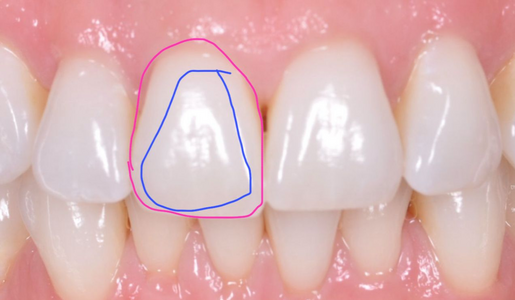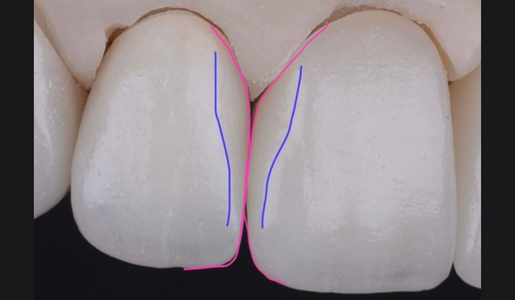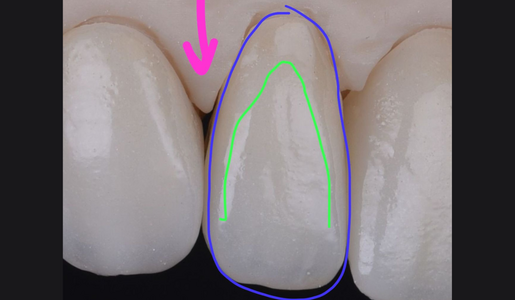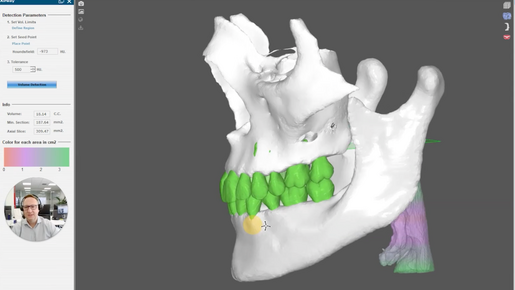Real shape in pink, perceived shape in blue.

By Christian Coachman
⋅ 3 min read
⋅ Updated Jun, 2025
In restorative dentistry, there's a subtle detail that makes a big difference in our daily work: the difference between real shape and perceived shape in dental restorations. This is an important topic that recently came up in a conversation with some of our DSD Clinics owners.
At first glance, it might sound like a technical distinction. But it actually impacts everything, from how a smile looks to how a dental restoration interacts with the soft tissue. In this article I will look at why understanding real vs. perceived dental shape is key in overcoming esthetic compromises.

What’s the difference between real and perceived shape in dental restorations?
Every tooth has two types of shape happening at once.
Real shape is physical. It’s the actual form of the tooth, the way it contacts the neighboring teeth, and how the papilla fills in the space. If you see a black triangle, that’s a real shape issue.
Perceived shape is visual. It’s how we interpret what we see, shaped by things like line angles and light reflection. You can keep the anatomy exactly the same but change the way it looks by modifying how light moves across the surface.
These two aren’t tied together. You can change one without touching the other. That’s where the opportunity lies. When we understand how they work separately, we can solve problems more precisely and with fewer compromises.

Another thing to understand is the difference between the real shape given by the real contour, usually trying to close all the spaces, and the perceived shape, given by the line angles, that can be more triangular and delicate.
Why both shapes deserve our attention
A lot of times, we sense that something doesn’t look quite right, but we can't explain why. That’s usually because we’re picking up on something in the perceived shape. Or the opposite: we think it looks fine but there’s a functional issue, like a black triangle that the patient will notice later.
Say a patient has recession and you need to close the black triangle. That’s real shape. But if they like how their tooth looks, you’ll want to keep the perceived shape exactly the same, so they don’t feel like something changed.
Or maybe the patient isn’t happy with the shape of their teeth and they feel too triangular. But you’ve got healthy papilla and good contacts. So in that case, you keep the real shape, and just tweak the reflection lines to make the tooth feel softer or more natural.
These are two very different situations. And they need different solutions. The better we get at spotting which one we’re dealing with, the better our outcomes will be.
When you're writing to your dental lab, it can be as simple as saying:
“Please adjust the real shape to close the interproximal space, but keep the perceived shape consistent.”
“Please modify the reflection lines to reduce the triangular perception, but don’t change the real shape.”
That clarity makes a huge difference. It saves time, reduces guesswork and leads to better esthetic and functional results.
Working with the lab: seeing what needs to be seen
Good outcomes start with good conversations. And that can often mean taking a step back and just seeing things more clearly.
One of the ways we support our dentists is by helping them see what actually needs to be seen. That might sound obvious, but it’s not. Sometimes something looks off, and we just can’t quite put our finger on it. That’s where experience, checklists and collaborative thinking come in.
Using a checklist helps a lot. Nobody remembers everything in the middle of a busy day. A structured process helps keep things from slipping through the cracks.
It also helps to ask the right questions. Not just “what do I see,” but “what am I trying to solve,” and “am I looking at a real or perceived shape issue?”
Sometimes, the quickest way to align is just to sketch over a photo. A quick drawing can say more than five back-and-forth emails. It’s a simple trick I like to recommend because it can save time and get everyone on the same page.

Here, we tried to close the distal space as much as possible and still respect the preps. The team did a great job overcoming the fact that this lateral was skinny and long (blue outline) by creating a nice green shape perception with the line angles (green).
The 'restorative planning moment': why timing changes everything
Here’s where a lot of problems happen. A tooth gets prepped before the plan is finalized. Once the prep is done, options become limited. The chance to collaborate is gone.
That’s why we’ve started calling this moment before prep the ‘Restorative Planning Moment’. It’s the ideal time for the dentist and lab to connect, talk about esthetics and biology and make sure everything is aligned before tooth structure is removed.
It sounds basic but it changes everything. When the dental lab is involved before the prep, you can make smarter decisions about real shape and perceived shape, and design the restoration with the full picture in mind.
There’s a lot of talk about modern dentistry and digital workflows, but this step – just pausing to align before you prep – might be one of the most powerful things you can do.
Key takeaways about the importance of shape in dental restorations
- Real shape and perceived shape are different, and understanding that difference is key to solving both functional and esthetic problems.
- You can change one without changing the other. That gives you more control and fewer compromises.
- Be clear with your lab: say exactly what you want to change and what you want to preserve.
- Use tools like esthetic checklists, smart questions and sketches to improve communication and save time.
- Always talk to your lab before prepping in complex cases. This restorative planning moment helps you make better decisions and get better results.
Work with a digital dental lab
If you're looking to elevate your restorative results by making these kinds of nuanced decisions with more clarity and confidence, the DSD Lab is here to support you. Our team works alongside clinicians every day to co-plan cases, refine esthetic strategies and translate design intent into final restorations with accuracy. We’re ready to help you see more, plan better, and achieve results that feel as good as they look.
Click below to learn about working with the DSD Lab and Planning Center through our memberships.
Follow us on Instagram, Facebook and LinkedIn for the latest in digital dentistry news.



